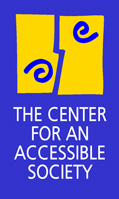
DISABILITY
ISSUES
INFORMATION
FOR JOURNALISTS
ABOUT
THE CENTER
Wed, 19 Mar 2003 -- Media Matters No. 26:
Planning your report to attract media attentionReleasing a report can be a good opportunity to attract the media to your issue or Center, providing there actually is news to be revealed. "Reports not only provide information and facts -- they can also contextualize issues into broader political and social arenas, chart trends and give voice to those affected," according to the SPIN Project.
In upcoming issues of Media Matters, we will look at ways to package your research report to maximize its potential to attract media attention. The tips in these next Media Matters come from material produced by the SPIN (Strategic Press Information Network) Project, a group which provides comprehensive media training, intensive media strategizing, and resources to community organizations across the country. Trainers from SPIN will be working with us on Media Matters: The Workshop in Washington, DC in June (more on the Workshop at http://www.accessiblesociety.org/mediamatters/mm24.html).
There are specific ways to construct a report and release it to the media so your message is communicated most effectively.
First and foremost, the report should be easy to read and factually accurate. As researchers, you know that data must be corroborated and confirmed -- but reasons beyond academic integrity also argue for this: The larger mainstream media outlets will often have fact-checkers peruse the report for statistical accuracy. Inaccurate data will make them lose interest -- fast.
It goes without saying that your report must be clean and free of typographical errors as well -- such mistakes make media question your group's capabilities.
The report should conform to statistical and journalistic accuracy. But it should also be written in such as way as to draw attention to the issue, frame it for maximum media impact, move your messages and influence policy.
What is your report about anyway? Why is it important to the "man on the street"? Use charts or graphs to drive home graphically what your report is about. What is the message you would like someone to remember?
Balance the statistical portion of the report -- which can be dry and numerical -- with clean hard-hitting language that summarizes your findings and communicates your messages. (Remember to use "banana words" -- see Media Matters no. 20.
Your report should educate readers. It should be read by others beyond the research community -- elected officials, policy-makers, reporters and, of course, consumers.
The SPIN Project believes that the main audience for ANY research report should be reporters and newsmakers, and counsels organizations to prepare their reports with this audience in mind, because it is through them that you reach the broadest audience.
In upcoming Media Matters, we'll look step-by-step at putting together a report that attracts media attention.
Contact us at info@accessiblesociety.org